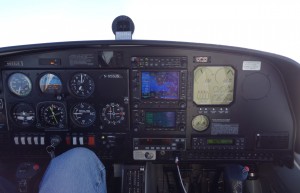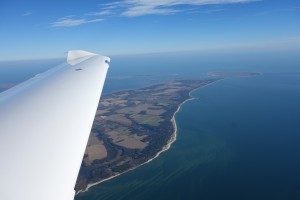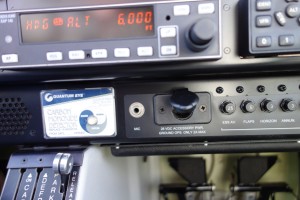I had the opportunity to pick up a Diamond Star DA40 this week. I had not flown a DA40 before so this is my first impression of the airplane. I’m a member of the Tidewater Flying Club and 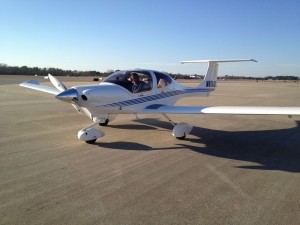 our club has just purchased a 2003 DA40, N653JS. The airplane was based at KSZF in Rhode Island and our club had arranged for some post purchase maintenance to be completed at KPGV in North Carolina. So the plan was for me to get to KSZF, receive training from an instructor to satisfy the insurance company (and to make me comfortable), and then fly N653JS to KPGV and get picked up for the ride back to our home base at KPHF. Lots of moving parts to this endeavor. I arrived in Providence, RI the night prior to the pick up and stayed at a hotel near the airport. The following morning my instructor for Diamond training, Jacob Hoffman, picked me up at 8:00 for the drive to KSZF. Jacob is an instructor for AirVentures, a flight school at KSZF. We arrived at the airport and started with a review of the manuals and then a preflight/discussion of the aircraft systems. Jacob was very knowledgeable and thorough. I was impressed with the size of the DA40. I’m 6’2″ and I thought that it would
our club has just purchased a 2003 DA40, N653JS. The airplane was based at KSZF in Rhode Island and our club had arranged for some post purchase maintenance to be completed at KPGV in North Carolina. So the plan was for me to get to KSZF, receive training from an instructor to satisfy the insurance company (and to make me comfortable), and then fly N653JS to KPGV and get picked up for the ride back to our home base at KPHF. Lots of moving parts to this endeavor. I arrived in Providence, RI the night prior to the pick up and stayed at a hotel near the airport. The following morning my instructor for Diamond training, Jacob Hoffman, picked me up at 8:00 for the drive to KSZF. Jacob is an instructor for AirVentures, a flight school at KSZF. We arrived at the airport and started with a review of the manuals and then a preflight/discussion of the aircraft systems. Jacob was very knowledgeable and thorough. I was impressed with the size of the DA40. I’m 6’2″ and I thought that it would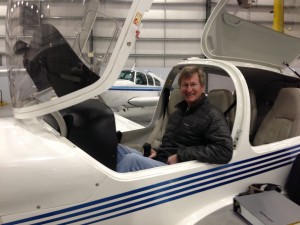 be a tight fit but I had plenty of headroom and legroom. One thing I continued to have problems with is that you enter the cockpit from the front of the wing. I’m used to getting into low-wing airplanes from behind the wing and so I kept walking around behind the wing only return to the front. I found the seats comfortable. The pilot and copilot seats are fixed and you adjust the rudder pedals fore and aft by pulling a cable. I was surprised at the legroom available for the backseat passengers. This DA40 also has a “ski” compartment in addition to the cargo area behind the rear passenger seats. This is a long “tube” that would allow you to put skis (or some such thing) in the aircraft. It is placarded with a 10 lbs max gross weight so you are not going to put much in the “ski” tube. After our preflight in hangar we got the DA40 outside and refueled. The start up is pretty straight forward and soon we were up and running. It was windy and there was a good crosswind on runway 23; a great way to learn a new airplane! Back to the rudder pedals, the pedals are close together and on each side there is a fixed metal bar (or bracket) that is
be a tight fit but I had plenty of headroom and legroom. One thing I continued to have problems with is that you enter the cockpit from the front of the wing. I’m used to getting into low-wing airplanes from behind the wing and so I kept walking around behind the wing only return to the front. I found the seats comfortable. The pilot and copilot seats are fixed and you adjust the rudder pedals fore and aft by pulling a cable. I was surprised at the legroom available for the backseat passengers. This DA40 also has a “ski” compartment in addition to the cargo area behind the rear passenger seats. This is a long “tube” that would allow you to put skis (or some such thing) in the aircraft. It is placarded with a 10 lbs max gross weight so you are not going to put much in the “ski” tube. After our preflight in hangar we got the DA40 outside and refueled. The start up is pretty straight forward and soon we were up and running. It was windy and there was a good crosswind on runway 23; a great way to learn a new airplane! Back to the rudder pedals, the pedals are close together and on each side there is a fixed metal bar (or bracket) that is 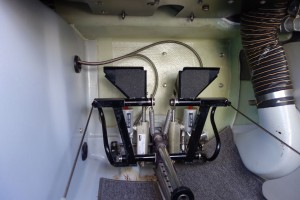 used to push the pedals to the out (away from the pilot) position. I was wearing a pair of light hiking boots (anticipating the cold weather) and my big feet came in contact with the fixed metal bar if I didn’t make sure to kept them close together. I believe the problem was my big feet combined with my boots and in the future I plan to wear a light weight pair of shoes. So, if you have big feet, be warned! After the upper air work we went to KPDV for an ILS and a few patterns. Then back to KSZF with a forced landing scenario. We ended the flight training with cross wind landings. I felt comfortable with the DA40 and Jacob was happy with me so with training completed I refueled and started on my way to North Carolina. I filed IFR at 6000′ via JFK and then down the coast to Delaware Airpark (33N) for relatively cheap fuel. ATC decided to completely change my clearance but with some knob turning I was on my way. (A hearty thank you to ForeFlight!) ATC said I had to go to 8000′ for some unknown reason and I continued at that altitude towards NYC for about 45 minutes in a >35 knot headwind. At that altitude the rpm was 2400 and the manifold press 21.3 with a OAT of +1 degrees C. Using a indicated airspeed of 130 knots I came up with a TAS of around 148 knots. ATC lowered me to
used to push the pedals to the out (away from the pilot) position. I was wearing a pair of light hiking boots (anticipating the cold weather) and my big feet came in contact with the fixed metal bar if I didn’t make sure to kept them close together. I believe the problem was my big feet combined with my boots and in the future I plan to wear a light weight pair of shoes. So, if you have big feet, be warned! After the upper air work we went to KPDV for an ILS and a few patterns. Then back to KSZF with a forced landing scenario. We ended the flight training with cross wind landings. I felt comfortable with the DA40 and Jacob was happy with me so with training completed I refueled and started on my way to North Carolina. I filed IFR at 6000′ via JFK and then down the coast to Delaware Airpark (33N) for relatively cheap fuel. ATC decided to completely change my clearance but with some knob turning I was on my way. (A hearty thank you to ForeFlight!) ATC said I had to go to 8000′ for some unknown reason and I continued at that altitude towards NYC for about 45 minutes in a >35 knot headwind. At that altitude the rpm was 2400 and the manifold press 21.3 with a OAT of +1 degrees C. Using a indicated airspeed of 130 knots I came up with a TAS of around 148 knots. ATC lowered me to 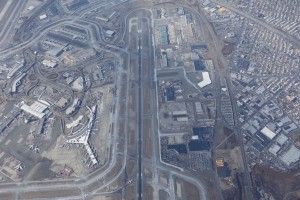 6000′ and I had a great view of JFK. I took some photos of NYC but there was a little haze and so the pictures didn’t turn out so well. ATC was not too busy and I finally turned towards the southwest and the headwind turned into a crosswind. It had been quite bumpy but I seemed to cross a cold frontal line and the turbulence had abated. I started to do a few more TAS calculations. I first used a higher power setting of 23′ manifold pressure (mp) and 2400 rpm. With a plus 3 degrees centigrade and an indicated airspeed of 130 I had a TAS 149. I was lowered again to 4000′ and adjusted to a “normal” cruise (according to the manual I was using for the DA40) of 23′ mp and 2200 rpm.
6000′ and I had a great view of JFK. I took some photos of NYC but there was a little haze and so the pictures didn’t turn out so well. ATC was not too busy and I finally turned towards the southwest and the headwind turned into a crosswind. It had been quite bumpy but I seemed to cross a cold frontal line and the turbulence had abated. I started to do a few more TAS calculations. I first used a higher power setting of 23′ manifold pressure (mp) and 2400 rpm. With a plus 3 degrees centigrade and an indicated airspeed of 130 I had a TAS 149. I was lowered again to 4000′ and adjusted to a “normal” cruise (according to the manual I was using for the DA40) of 23′ mp and 2200 rpm. 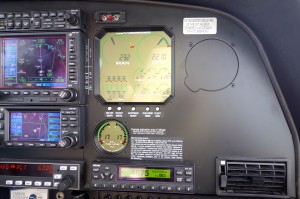 With outside temp of 8 degrees C I had a TAS of 141 knots. The aircraft really seems to be comfortable at this power setting, smooth and quiet (at least with my Lightspeed headset on). I landed at 33N and got fuel. I calculated a burn rate of 10.5 gallons an hour. I did several more TAS calculations on the second leg from 33N to KPGV and always had a TAS greater than 140 knots. Again, this DA40 is very comfortable in cruise with a 23 mp and 2200 rpm. A few of observations. This airplane has incredible visibility but you’d better wear a hat if you’re heading into the sun. The vents seemed to work well and afforded adequate ventilation however it wasn’t a warm day. Jacob said the DA40 actually wasn’t bad in
With outside temp of 8 degrees C I had a TAS of 141 knots. The aircraft really seems to be comfortable at this power setting, smooth and quiet (at least with my Lightspeed headset on). I landed at 33N and got fuel. I calculated a burn rate of 10.5 gallons an hour. I did several more TAS calculations on the second leg from 33N to KPGV and always had a TAS greater than 140 knots. Again, this DA40 is very comfortable in cruise with a 23 mp and 2200 rpm. A few of observations. This airplane has incredible visibility but you’d better wear a hat if you’re heading into the sun. The vents seemed to work well and afforded adequate ventilation however it wasn’t a warm day. Jacob said the DA40 actually wasn’t bad in 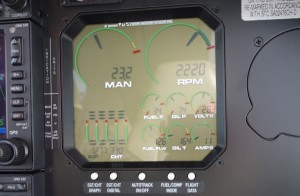 the summer once you were airborne and he has flow them for a flight school in Florida. The wings are long and low and it would be easy to taxi into something sticking up like a taxiway light or sign by a taxiway (note the photo below). Also below is a photo of the adapter plug for a iPad charger. This plug is limited to 2 amps and I plugged a iPad charger into it and it created havoc with static on the radios. It also is labeled “for ground use only” and I didn’t
the summer once you were airborne and he has flow them for a flight school in Florida. The wings are long and low and it would be easy to taxi into something sticking up like a taxiway light or sign by a taxiway (note the photo below). Also below is a photo of the adapter plug for a iPad charger. This plug is limited to 2 amps and I plugged a iPad charger into it and it created havoc with static on the radios. It also is labeled “for ground use only” and I didn’t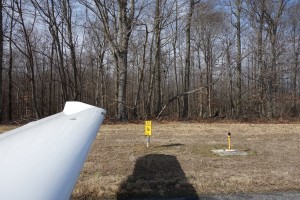 notice this until after the radio static problem. It was a long day and I was happy to finally get home at about 10:00 pm! Overall I’m happy with the DA40 and think it will be a good addition to our club.
notice this until after the radio static problem. It was a long day and I was happy to finally get home at about 10:00 pm! Overall I’m happy with the DA40 and think it will be a good addition to our club.

